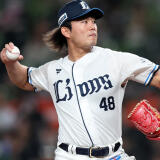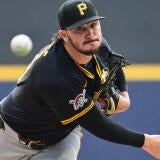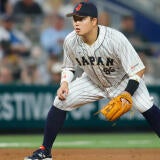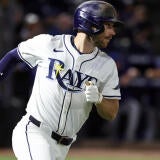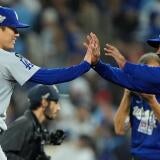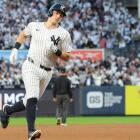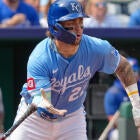Fantasy Baseball: Six hot starting pitchers to buy and three to sell, from Eric Lauer to Noah Syndergaard
Now is a better time than ever to get trade talks rolling
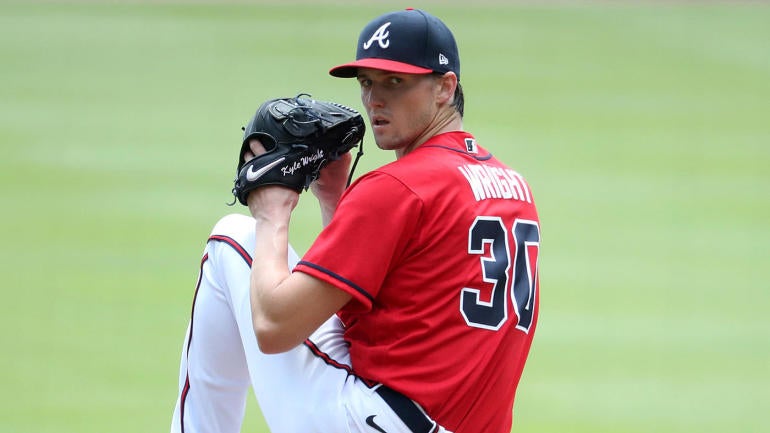
Despite posting a 3.19 ERA last season, Eric Lauer entered 2022 with an ADP of just 326.1 in NFC drafts, so it's clear nobody was really buying his apparent breakout. Through three starts, however, he's sporting a 2.20 ERA with the peripherals to match, so clearly, the Fantasy community missed on Lauer, right? It's not that simple. Because, while Lauer did pitch more effectively in 2021 than we had seen in previous seasons, his 3.87 expected ERA indicated there was some good luck involved, and with a good-but-not-great strikeout rate and volume questions, skepticism was certainly warranted. However, it's a lot harder to be skeptical after what we've seen from him so far.
Lauer was dominant Sunday against the Phillies, striking out 13 in six shutout innings, and while Kyle Schwarber (and others) might argue he got some help from umpire Angel Hernandez, Lauer earned his results in this one. He racked up 17 swinging strikes on 98 pitches, including a whopping 11 on 37 four-seam fastballs, a huge number, and he did it while averaging 94.0 mph with his fastball – he was at 92.6 last season.
Lauer is throwing quite a bit harder than he did last season, both on average and in terms of his top-end velocity; he has already thrown 13 pitches over 95 mph, compared to nine last season and 12 for his career prior to 2022. He already had a pretty good fastball, with a 26.5% whiff rate in 2021, but that's up to 35.6% in the early going. Lauer has taken a relatively solid skillset and added above-average velocity, making the entire package play up.
I'm not quite sure I buy Lauer being a difference maker moving forward – the rest of his arsenal still seems to lack a putaway pitch, and it's hard to get this many strikeouts consistently if your fastball is your best swing-and-miss pitch – but I'm certainly less skeptical of him than I was coming into the season. It's only three starts, but Lauer appears to have made a skills leap, and it's worth buying into.
And he's not alone. We've seen a handful of pitchers make similar leaps in the early going, with the top of the pitcher ranks through the first three weeks of the season sporting some surprising names. I'm buying Lauer, and here are six more names I'm buying into – along with three whose hot starts I'm fading hard.
Five more starters to buy
I'm buying Carrasco for fairly straightforward reasons: He's been a very good pitcher for a long time. That wasn't true in 2021, of course, and I think many people might have just looked at his past three seasons and seen him struggle in two of three and written him off. However, he was never right after a spring training injury last season, and in 2019 he was pitching through a cancer diagnosis and round of treatment. The only time he's been healthy the past three seasons was 2020, and he had a 2.91 ERA and 82 strikeouts in 68 innings.
He was healthy this spring and he's healthy now, so I'm buying into Carrasco once again being a very good pitcher for as long as he can stay healthy. At 35 and coming off surgery to clear up loose bodies in his elbow this offseason, maybe there's more risk for Carrasco than most pitchers. But, his track record suggests he's going to keep being good as long as he holds up, and he's healthy and productive right now. That's more than you can say for a lot of pitchers.
Wright is the No. 2 player in Fantasy after three starts, but the most impressive thing about what he's done so far is allow just two walks on 66 batters faced – that's a 3.0% walk rate. In parts of four seasons from 2018 through 2021, Wright had a 14.8% walk rate; even his much more manageable 7.6% career rate at Triple-A is more than double what he's managed so far. It's an incredibly small sample size, obviously, but Wright is working in the strike zone more often so far, with 51.7% of his pitches thrown in the zone so far, compared to a 44.9% mark for his career. His contact rate allowed on pitches in the strike zone is down to 79.8% – his career mark is 82.7%, while the league average is 82% – but the biggest improvement he's made so far has been in garnering a 36.2% chase rate, compared to a 25.5% mark for his career.
Opposing hitters are having trouble laying off Wright's pitches out of the strike zone, which is a pretty good sign – it leads to both whiffs and weak contact. And it's come along with a significant change in approach, as Wright's most-used pitch through three starts is his curveball, which he's using 33.8% of the time. Previously, Wright's curveball usage has been in the 12-14% usage range, though it's worth noting that this is a different pitch than we've seen from Wright in the past – he's throwing a tighter, harder version of the pitch with less movement at 84.3 mph, compared to 80.6 in the past. He's added a few ticks of extra velocity to all of his pitches, but the curveball is the biggest gainer, and he's combined that with a tweaked delivery with a lower arm angle that allows him to release the ball 2-4 inches closer to the plate, depending on which pitch he's throwing.
Which is all to say, Wright has made enough tweaks that we can say he's a different pitcher than we've seen in the past. Whether he can keep this level of play up is a different question, and given the dramatic improvements we've seen in his control especially, betting on some regression makes sense. But I don't think this is entirely a fluke, and I think it's possible Wright really has taken a step forward with these tweaks. I'm buying.
We've seen three starts from Luzardo, and it's been a mixed bag – he was dominant in his first, striking out 12 in five innings, then he gave up four earned runs on seven hits with just three strikeouts in 4.1 innings in his second against the Cardinals; he followed that up with five innings of one-run ball but he walked four against the Braves Sunday. All in all, however, there's been more good than bad for Luzardo, what with a 37.5% strikeout rate. Luzardo is throwing his fastball 1.5 mph harder than he did a year ago, and it was the reports of that which made him grow into such an intriguing sleeper in the spring.
However, the real key for him has been his breaking ball. It has been his most-used pitch in each start and he has 26 swinging strikes with it across his three starts. Throwing harder hasn't made Luzardo's fastball an overpowering pitch – it's still getting hit pretty hard and he doesn't get many whiffs with it – so it would be nice to see him gain more confidence in his changeup to supplement the breaking ball, since he's actually throwing his changeup less often than ever. Even with the promising start, Luzardo remains a work in progress, but his curveball has looked like a dominant go-to pitch, and the added velocity has increased his margin for error. If Luzardo rediscovers the change, he could be even better, but he already looks pretty good.
Megill was undervalued coming into the season after posting a 26.1% strikeout rate and 3.87 expected ERA in 2021, but he also carried the potential for even more once we found out he was throwing harder than his 94.6 mph average fastball velocity from a year ago. He came out averaging 96.1 in his first start and then 96.7 in his second, striking out 11 with zero walks in 10.1 innings and talking about pushing to triple digits at the fastball.
Megill has stalled out somewhat as his outings have gotten longer in two starts since, as he's struck out just 20.8% of batters since while allowing six runs in 12.2 innings. He hasn't been bad during that stretch, by any means, but he just hasn't looked quite as impressive as he did in those first two starts. It's a reminder that velocity can fluctuate, too. Megill is throwing harder than last season, but it's now a question of whether we're talking about maybe a 0.5-1.0 mph or 1.5-2.0, and if it's the former, there's probably less room to dream on a significant breakout. That high floor is still there, but I'm more excited about a few other pitchers now.
Kelly is another pitcher who came out of the gate hot but hasn't been able to sustain his velocity gains in his most recent couple of starts, which makes it fair to question whether his breakout is likely to sustain. On the whole, I feel pretty similar about Kelly as I do Megill, in that he's a relatively high floor pitcher who may not have a significant ceiling, though, in Megill's case, it seems tied more to a non-fastball pitch – his changeup.
Kelly's changeup has been terrific in the early going, generating a 45.5% whiff rate and weak contact when batters do put it into play. He's bumped it to the No. 2 priority spot in his repertoire, throwing it 23.1% of the time compared to 17.5% of the time, and it's a materially different pitch than the one he threw last season – it has about 200 RPM more spin, with more movement across both the horizontal and vertical planes, along with more velocity, even relative to his overall gains. He experimented with new grips in the offseason, and this new approach seems to be working for him.
I wouldn't mind seeing Kelly become even more changeup-heavy, given the success he's had with it, just because it doesn't seem like the rest of his pitches really stand out. I'm buying a step forward for Kelly as is, but if he can sustain the increased velocity he threw in the spring and in his first two starts – he averaged 93.1 and 92.5 mph with his four-seam fastball – I could see him being a top-40 guy.
Heaney would be even easier to buy into if not for the shoulder soreness that landed him on the IL after his first two starts of the season, though that injury is not currently considered a serious one. Still, while it was just two starts for Heaney, they were incredibly impressive, with tangible changes that I'm willing to buy into.
The Dodgers apparently identified Heaney's breaking ball as a key change to make when they signed him early in free agency, and as Scott White noted, if the Dodgers believe in someone, you probably should, too. But this isn't just about an appeal to authority; Heaney's new, harder slider was racking up a ton of whiffs in his first two starts. He's always had a very good fastball that he can throw for whiffs, but Heaney's breaking ball has been erratic, and his changeup never developed into much of a weapon either. The new breaking ball had the look of a legitimate weapon, and while the sample size is small, I'm definitely stashing Heaney during his IL stay, and my expectations are a lot higher now than they were at the beginning of the season. He might be a top-40 pitcher if healthy.
Three starters to sell
With a 2.12 ERA and 0.82 WHIP, it sure looks like Syndergaard is off to a great start, but I'm not buying it at all. He's got a 16.4% strikeout rate and his velocity is down significantly across the board. Maybe that'll turn around as he gains arm strength, but given that he was back from Tommy John surgery (with similar velocity) last season, I'm not optimistic, and I have a hard time seeing Syndergaard continuing to be effective. After all, he was pretty disappointing the few seasons before his injury when he was the hardest throwing starter in the game. I just can't bring myself to be excited when he's averaging 94-94 with his fastball.
I don't see any reason to think Plesac has rediscovered his 2020 form so far; in fact, though it's a small sample, he's arguably been even less impressive than he was a year ago. Plesac's strikeout rate sits at just 14.5%, while his expected wOBA on contact allowed is .473, compared to last year's .364 mark. Maybe there are some tweaks he could make – throwing his slider and curveball more, like teammate Shane Bieber – but I think Plesac is much more likely to have an ERA north of 4.00 than below.
As with Plesac and Syndergaard, Bundy is off to a strong start that may have some believing he is rediscovering his former self, and like Plesac and Syndergaard, I'm not buying it at all. Bundy is living on quality of contact suppression right now, and while he's been better in that regard than his reputation for his career – Camden Yards probably made his homer issues look worse than they otherwise might have, especially – I don't see a path to him being a consistently effective pitcher without strikeouts. Bundy's velocity is down to 89 mph and his slider is his only pitch with a whiff rate higher than 25%, so I don't think there's some latent strikeout potential waiting to be unleashed. Bundy will be better than last year's 6.05 ERA, but I see no reason to think he's going to recapture his 2020 form here.

